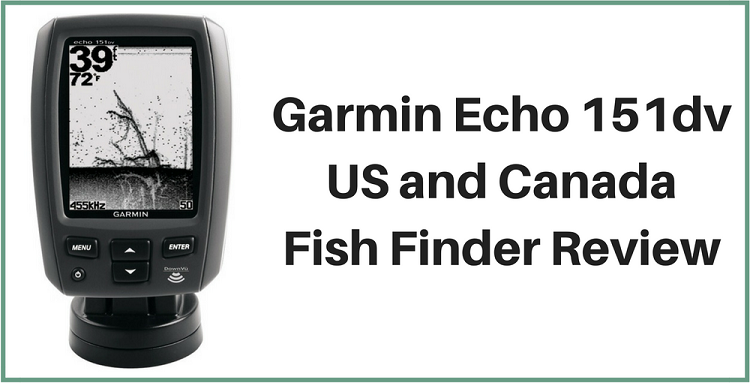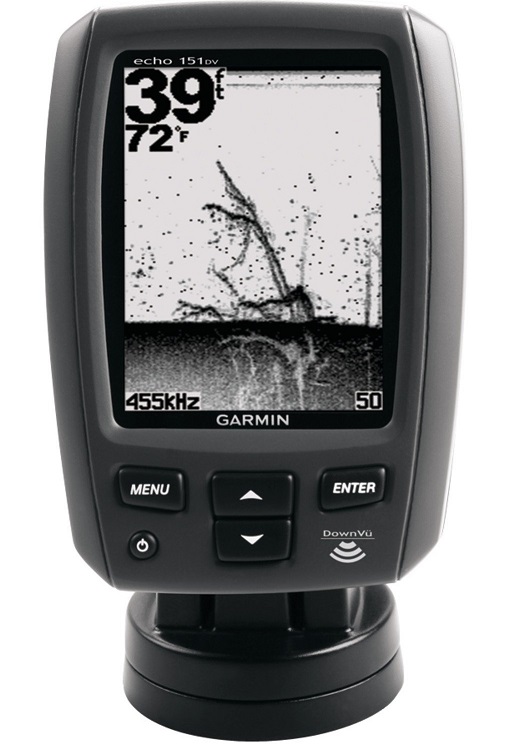Garmin Echo 151dv Review

When it comes to fishing, you want to make sure that you wind up with a big catch at the end of the day. Sure, it can be relaxing to be out on the water regardless of what you get, but coming home empty-handed feels so unfulfilling.
So, to help maximize your potential on the water, you will want a fish finder. These handy devices send sonar signals into the water so you can see where fish are (and aren’t). Having one on your boat ensures that you aren’t wasting your time in empty sections.
Today I’ll be showing you the Garmin Echo 151dv. This is a relatively simple device, but it has everything you need to make sure that you get a bite.
Garmin Echo 151dv Features
8-Level Grayscale Imaging
High-end fish finders will come in high-definition color, but many fishermen prefer grayscale because it can be easier to read. Having a variety of colors on your screen can get confusing, but here you only have to worry about black and white. With eight levels of imaging, you get a high-contrast picture which should help you locate your next catch.
Easy to Use Menu
Fishing is a simple sport, so your fish finder should be as well. Some models are bogged down with menu buttons and options, but the Echo 151dv keeps things straightforward and user-friendly. Navigating the menu on this device doesn’t take a degree in computer sciences.
77/200 kHz DownVu Scanner
To know how well your fish finder will perform, you have to know how powerful it is. In this case, the Echo comes with a DownVu scanner, with a frequency range of 77 to 200 kHz. The more power you use, the wider and deeper you can go. Best of all, the device adjusts automatically based on the depth of water below you.
This transducer is also transom mounted, meaning that you can place it almost anywhere on your boat. Maximum depth for this model is 1600 feet, making it ideal for almost all fishing environments.
Pros
- Compact design
- Easy to use
- Quick installation
- Easy to read screen
- Simple menu options
- Cost-effective
- Adjustable mounting bracket
- Vast depth range
- Switch from shallow to deep water
Cons
- Screen may be too small for some users
- It can be hard to distinguish some objects from others
Highlighted Features
- Compact and lightweight design
- Installs practically anywhere on your boat
- Transom mounted transducer for faster results
- Eight-level grayscale imaging
- High contrast, clutter-free screen
- Water temp and depth gauge included
- Versatile mounting bracket
- Tilt, swivel and release the monitor with ease
- 77/200 kHz DownVu transducer
- Switch from shallow to deep water quickly
- Depth range from 1600 feet
>>Click here to check customer reviews and rating<<
FAQs- Garmin Echo 151dv Review
Does it only show fish directly below the boat, or can it show the sides as well?
Can I mount this to any boat? I want to bring it on my kayak.
Is the unit waterproof?
Tips and Tricks
If you’re still new to the fish finding game, then you may be confused as to what you see on your screen, and you may be wondering how to maximize your potential. So, let’s go over how to read your finder as well as optimize its position on your boat.
Learn About Fish: the more you know about the fish you’re going after, the better you will be at understanding your fish finder. For example, if you are going after a species that prefers warm, shallow water, then you won’t find them in cold, deep water.
Soft vs. Hard Surface Lines: you’ll instantly recognize the bottom of the lake or body of water that you’re in, as it will show up as a solid line on the bottom of your screen. Soft lines mean that the ground is soft, and hard lines mean that it is harder. Going back to knowing your species, you will want to pay attention to what kind of bottom surface it prefers.
Arching: when a fish passes through the finder’s scope, it will show up as an arch. If the fish stays in one place, however, it will be a flat line. Know the difference and set your bait accordingly.
Map yourself: in this case, you don’t have a GPS built in the finder, so you’ll need to use one in tandem to get your best results. The reason for this is that you want to track where the best spots are, as well as be able to chart your course back home. If you aren’t paying attention to where the fish are geographical, then what’s the point?
Reposition if necessary: if you’re not getting the readings you want, you may think that the finder is defective. However, with transom mounted transducers, most of the interference can be coming from its placement on your boat. Reposition it before you do anything else and see if that changes things.
Final Verdict
If you want a fish finder that is easy to use and will give you quality results, then the Garmin Echo 151dv for you. With an easy to use menu and an uncluttered screen, you’re sure to find your next big fish in no time. Garmin fish finders usually give great results so this product from their range should be no different.
We like to share product recommendations with you and hope you like them! Just to make you aware FishingLab may collect a small share of sales or other compensation from the links on this page.

